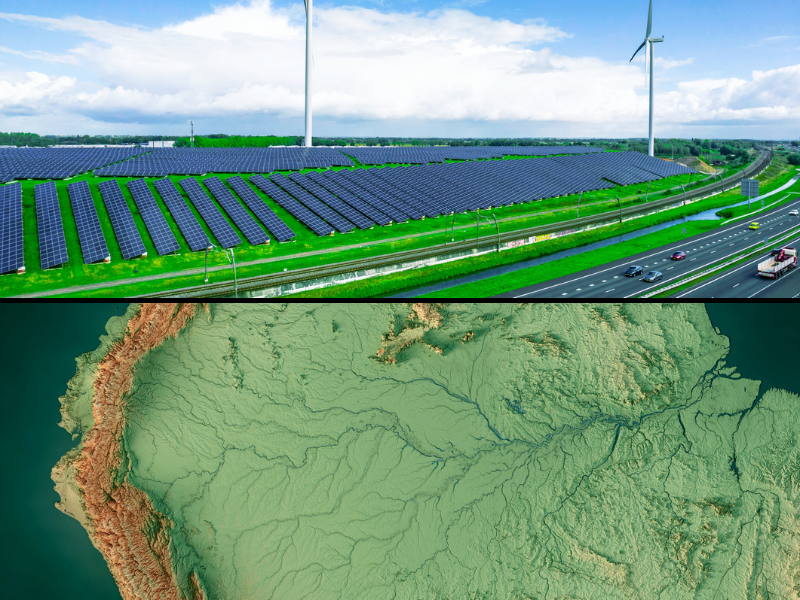Climate Change Weekly #178
A key mechanism for fighting climate change, some environmental activists and politicians say, is to increase the amount of electricity produced from renewable sources that do not emit carbon dioxide (CO2).
As nearly everyone knows, a key problem with wind and solar power is their intermittency, which makes those power sources difficult to accommodate in the electric grid. To provide power when wind and solar aren’t producing energy, and to regulate their variable power output when they are, requires expensive “backup generation,” largely from running fossil fuel or nuclear power plants at less-than-efficient levels: On-again, off-again is never as efficient as keeping a power plant running at a steady pace.
The intermittency burden increases as the percentage of renewable sources contributing to the grid is increased. For Texas’s ERCOT grid with 10.6% wind, the additional costs are approximately $19/MWh for generation plus approximately $6.50/MWh for transmission.
To overcome renewable power’s intermittency problem and thus get the full CO2-reducing benefit from expanded renewable power, the industry is searching for ways to store excess electricity generated when the wind blows and the sun shines, to be released when wind turbines are not turning or solar panels are not generating power due to clouds or at night.
Author and inventor Rud Istvan notes “in principle [there are] only five ways that generated electricity can be subsequently ‘stored:’ potential energy (e.g. pumped hydro), kinetic energy (e.g. flywheels), electrostatic energy (capacitors), electrochemical energy (batteries), and chemical energy (e.g. water hydrolysis).”
Pumped hydro storage (PHS) is widespread and efficient where suitable, affordable terrain (hilly or mountainous regions) with a regular water supply is available. Most electrical grids in developed countries already have taken advantage of PHS to the extent they can, including supporting renewable power generation in the alpine regions of Austria, Germany, and Switzerland. Most places favorable for wind (Great Plains states, Denmark, northern Germany) or solar (the Mojave Desert or Death Valley) are unsuitable locations for PHS.
Kinetic energy storage using large rotors or flywheels to generate electricity and electrostatic storage in capacitors are ubiquitous in the electric power industry but can store only enough energy to provide transient voltage/frequency regulation. Neither can store enough energy for bulk wind and solar needs.
Battery storage is tremendously expensive at commercial scales, requires a great deal of land, and often uses toxic and/or corrosive chemicals. A123 Systems LLC attempted to develop a utility-scale battery pack, but despite more than $263 million in federal support, it lost more than $500 million, declared bankruptcy, and was sold off to a Chinese company at a $119 million loss. The battery system it created cost $14.4 million to back up a single $3.5 million 2 MW wind turbine.
Chemical energy storage is even more expensive and less efficient than battery power. Only experimental systems exist.
Istvan concludes, “Utilities already utilize four out of five forms of energy storage wherever they make sense. It is very unlikely that any grid storage solution (other than PHS where feasible) could ever practically cover the intermittency of high penetration utility scale wind and solar.”
— H. Sterling Burnett
SOURCE: Climate Etc.
IN THIS ISSUE …
Shale revolution boosts trade, chemical industry … UK government cuts green energy, climate research … Carbon dioxide, boon not bane for the biosphere … Dams butcher biodiversity … China’s carbon market collapses
SHALE REVOLUTION BOOSTS TRADE, CHEMICAL INDUSTRY
Due primarily to the shale gas revolution, the $800 billion U.S. chemicals industry will experience 3.2 percent growth in 2015 and more than 3 percent in 2016, according to the American Chemistry Council (ACC). With the Federal Reserve estimating just 1.0 to 2.3 percent GDP growth for the U.S. economy as a whole through 2018, ACC forecasts the domestic chemical industry’s growth to exceed that of the nation as a whole for years to come, topping 5% between 2017 and 2019. The growth is expected to accompany record trade surpluses for the industry by 2020.
Fracking released abundant and cheap natural gas and natural gas liquids (NGLs), including ethane, which are key feedstocks and fuel for the chemical industry. Less than a decade ago, the domestic chemical industry was in decline as natural gas prices were high and estimated reserves low. Chemical manufacturing was moving overseas. All that has changed in response to the low gas prices brought about by the fracking revolution. ACC reports 238 U.S. chemicals companies have announced investment projects in 2015 worth a total of $145 billion, up from $90 billion in announced projects as of mid-2014.
SOURCE: Wall Street Daily
UK GOVERNMENT CUTS GREEN ENERGY, CLIMATE RESEARCH
Support for green energy and funding for the Department of Energy and Climate Change (DECC) seems to be waning in the UK. With core departments’ budgets, including education and health care, off-limits, Chancellor George Osborne is expected to make steep cuts in some non-core programs, including climate and energy programs, in an effort to balance the budget or at least significantly reduce the government’s annual deficit. The environmental think tank Green Alliance has calculated DECC could be receiving just £40 million by 2018–19, a cut of 90 percent from its 2014–15 budget of £402 million.
In addition, the government is concerned the cost of green energy subsidies, primarily for wind farm and solar installations, is expected to top the government’s self-imposed cap of £7.6 billion a year by 20 percent, more than £1.5 billion. Absent a reduction in green energy commitments and accompanying charges, by 2020 every household in the country will be forced to pay an estimated £170 (roughly $264) a year to support the renewable electricity schemes promoted by the previous coalition government. To avoid this substantial increase, Osborne is expected to abandon the previous coalition government’s increase in environmental taxes such as the Carbon Price Floor, charged on fossil fuels, and the Climate Change Levy, which businesses pay on their energy use.
SOURCES: The Telegraph and Breitbart UK
CARBON DIOXIDE, BOON NOT BANE FOR THE BIOSPHERE
With 2050 estimates of human population consistently topping 9 billion people, requiring a doubling of food production, research scientists Sherwood, Craig, and Keith Idso say the human-induced increase in atmospheric carbon dioxide will be a good thing.
The Idsos estimate world food production will be only 37 percent greater relying solely on anticipated improvements in agricultural technology. But risking carbon dioxide levels can overcome the shortfall. Not only is carbon dioxide a plant fertilizer, increasing the total biomass and vegetable, seed, and fruit production, but it also reduces water loss through transpiration. This is critical because, as researcher Jim S. Wallace noted in 2000, increased food production will require more, and more efficient, water use. Wallace wrote we must do everything we can “to fix more carbon per unit of water transpired.”
Thousands of laboratory and field experiments have demonstrated elevated concentrations of atmospheric carbon dioxide reduce plant water loss by transpiration, while simultaneously enhancing plant photosynthesis and biomass production. Together, those phenomena enable Earth’s vegetation to produce considerably more food per unit of water used in the food production process.
And if increased carbon dioxide is contributing to a modest increase in global temperature, so much the better for human health. The Idsos cite a study in the Lancet using data obtained from 384 locations around the world, examining a total of 74,225,200 human deaths that occurred between 1985 and 2012, concluding “more temperature-attributable deaths were caused by cold (7.29%) than by heat (0.42%),” which makes cold in excess of 17 times more deadly than heat.
SOURCE: CO2 Science.org
A new study in PLOS One shows hydroelectric dams take a heavy toll on biodiversity. Large hydroelectric dams are being constructed worldwide at an unprecedented rate in an effort to electrify developing countries without increasing greenhouse gas emissions. A study by researchers at the University of East Anglia (UEA) shows the Amazonian Balbina Dam is having a dramatic effect on tropical rainforest biodiversity, including a loss of mammals, birds, and tortoises from the vast majority of islands formed by the creation of the vast Balbina Lake.
The Balbina Dam is one of the world’s largest hydroelectric dams in terms of total flooded area. Its creation resulted in a formerly unbroken landscape of undisturbed tropical forest converted into an archipelago of 3,546 islands. The study found large vertebrates, including mammals, large game birds, and tortoises disappeared from most islands formed by the creation of the Balbina Lake. Of the 3,546 islands created, only 25 are likely to still harbor at least four-fifths of all 35 target species surveyed in the study.
Lead author Dr Maíra Benchimol reports, “We found that only a few islands larger than 475 hectares still contained a diverse community of animal and bird species, which corresponds to only 0.7 per cent of all islands in the reservoir.”
Coauthor Carlos Peres, from UEA’s School of Environmental Sciences, said, “The Brazilian government is currently planning to build hundreds of new dams in some of the world’s most biodiverse tropical forest regions. But the high biodiversity costs of mega dams should be carefully weighed against any benefits of hydropower production.”
SOURCE: Science Daily
CHINA’S CARBON MARKET COLLAPSE
China committed to capping its carbon dioxide emissions and to cut the amount of carbon dioxide it produces per unit of economic growth by 60 to 65 percent from 2005 levels by 2030. That commitment depends in large part on the success of the carbon emissions trading scheme the country is establishing … but the results thus far are not promising. Analysts blame regulatory uncertainty, a lack of transparency, and possible favoritism shown to large influential companies as undermining the seven regional carbon trading markets that are intended to be merged into a national market by 2017.
Three of the regional markets, Tianjin, Hubei and Chongqing, have postponed carbon restriction deadlines to give companies more time to meet targets and avoid fines, raising concerns about the integrity of trading rules. A trader who requested anonymity noted, “It is impossible to check if the authorities are allowing big influential companies to flout the rules because emissions data is not revealed.”
China said it would need to invest 41 trillion yuan ($6.6 trillion) to meet its UN pledges with trade in the national carbon market expected to cover about 30 percent of the annual investment by 2020. However, prices in five of the markets have fallen sharply, with permits on the Shanghai market at the end of its compliance year listed at 15.5 yuan, down 38 percent from its launch, and permits in the biggest exchange in Guangdong dropping 73 percent to 16 yuan. Low demand has meant minimal liquidity, with just 2 percent of the permits handed out annually traded in the regional markets during their first two years of operation.
SOURCE: Reuters





